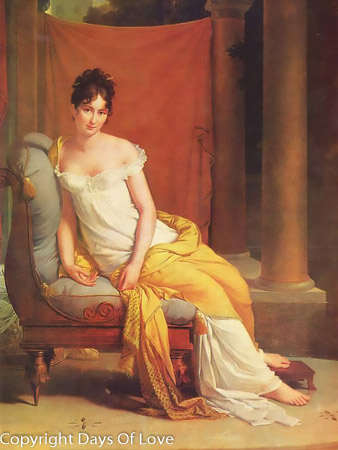 Jeanne-Françoise
Julie Adélaïde Récamier (4 December 1777 – 11 May 1849), known as Juliette,
was a French socialite, whose salon drew Parisians from the leading literary
and political circles of the early 19th century.
Jeanne-Françoise
Julie Adélaïde Récamier (4 December 1777 – 11 May 1849), known as Juliette,
was a French socialite, whose salon drew Parisians from the leading literary
and political circles of the early 19th century.Partner Germaine de Staël
Queer Places:
Ancienne Abbaye-aux-Bois, 16 Rue de Sèvres, 75007 Paris, Francia
Montmartre Cemetery, 20 Avenue Rachel, 75018 Paris, Francia.
 Jeanne-Françoise
Julie Adélaïde Récamier (4 December 1777 – 11 May 1849), known as Juliette,
was a French socialite, whose salon drew Parisians from the leading literary
and political circles of the early 19th century.
Jeanne-Françoise
Julie Adélaïde Récamier (4 December 1777 – 11 May 1849), known as Juliette,
was a French socialite, whose salon drew Parisians from the leading literary
and political circles of the early 19th century.
Beautiful, accomplished, and with a love of literature, Juliette was shy and modest by nature. From the earliest days of the French Consulate to almost the end of the July Monarchy, her salon in Paris was one of the chief resorts of literary and political society that followed what was fashionable. The habitués of her house included many former royalists, with others, such as General Bernadotte and General Moreau, more or less disaffected to the government. This circumstance, together with her refusal to act as lady-in-waiting to Empress consort Joséphine de Beauharnais and her friendship for Germaine de Staël, brought her under suspicion. In 1800 Jacques-Louis David began his portrait of her, but left it unfinished on learning François Gérard had been commissioned to paint a portrait before he had.
It was through Mme de Staël that Mme Récamier became acquainted with Benjamin Constant, whose political equivocations during the last days of the Empire and the first of the Restoration have been attributed to her persuasions. Mme Récamier was eventually exiled from Paris by the orders of Napoleon I. After a short stay at her native Lyon, she proceeded to Rome, and finally to Naples. There Mme de Récamier was on exceedingly good terms with Joachim Murat and his wife Caroline Bonaparte, who were then intriguing with the Bourbons. She persuaded Constant to plead the claims of Murat in a memorandum addressed to the Congress of Vienna, and also induced him to take up a decided attitude in opposition to Napoleon during the Hundred Days.
Her husband had sustained heavy financial losses in 1805, and she visited Mme de Staël at Coppet in Switzerland.[7] There was a project for her divorce, in order that she might marry Prince Augustus of Prussia, but, though her husband was willing, it was not arranged. In her later days she lost most of what was left of her fortune; but she continued to receive visitors in her apartment at L'Abbaye-aux-Bois,[8] a 17th-century convent (demolished in 1907) situated at 16 rue de Sèvres in Paris, to which she retired in 1819.
In 1859, Souvenirs et correspondances tirés des papiers de Madame Récamier was edited by Madame Lenormant. See Mme Lenormant's Madame Récamier, les amis de sa jeunesse et sa correspondance intime (1872); Mme Mohl, Madame Récamier, with a sketch of the history of society in France (1821 and 1862); also François Guizot in the Revue des deux mondes for December 1859 and February 1873; H Noel Williams, Madame Récamier, and her Friends (London, 1901); E Herriott (Engl. trans., by Alys Hallard), Madame Récamier et ses amis (1904) (elaborate and exhaustive).
Juliette Récamier died in 1849 of cholera at the age of 71 and was buried in the Cimetière de Montmartre in Montmartre, at the time a village north of Paris.
My published books: